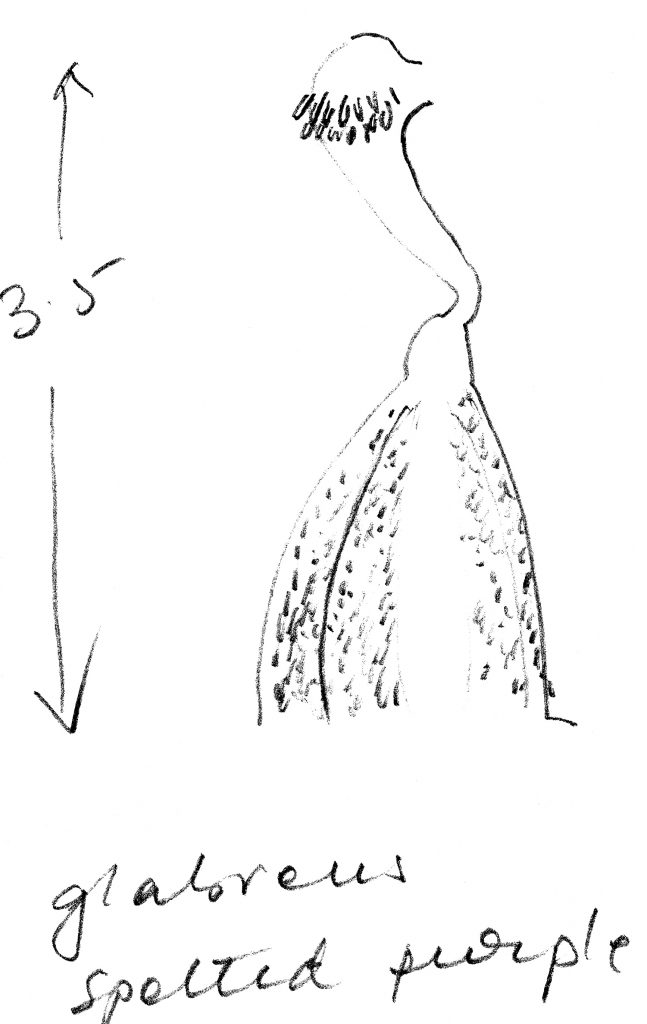Viola pubescens. Aiton
Kim’s collected notes, unedited. 12 photographs of Viola pubescens and V. pubescens var scabriuscula and 3 drawings.

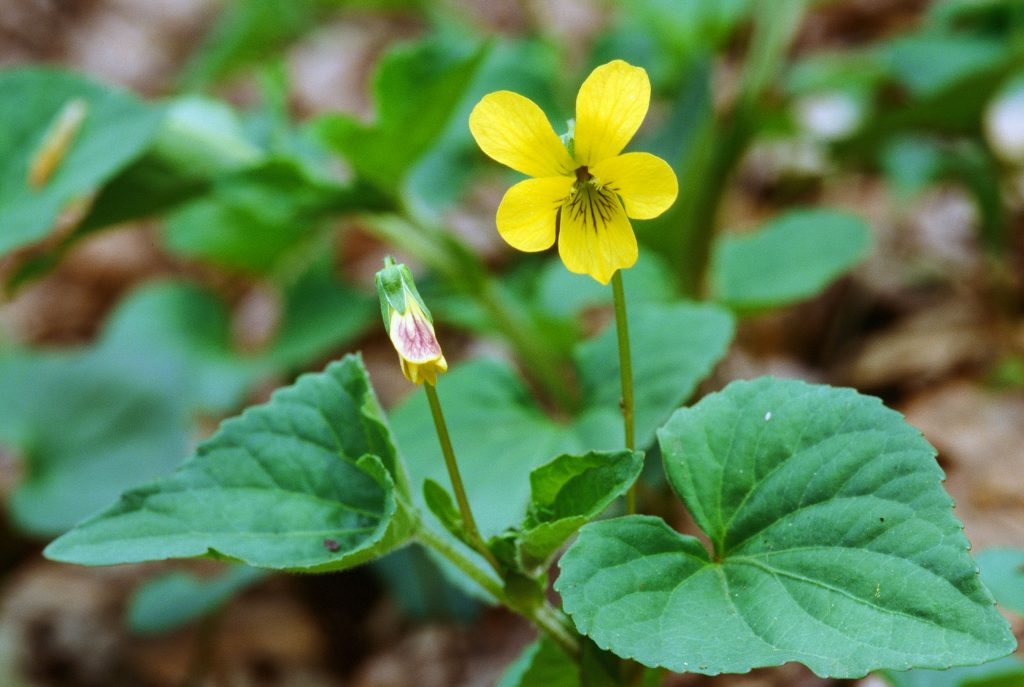
Sect. Chamaemelanium subsect. Nudicaules [Marcussen, 2011].
William Aiton, 1731-1793.
2N=2x=12 (a diploid species), Clausen 1929, IPCN: Love, A. and Love, D., 1982; Canne, J.M., 1987.
Pure V. pubescens on Dolerite/diabase in two state game lands in PA, Walnut Run and N. Bucks County. Many of the State Game Lands are dolerite, full of large rocks so were areas unsuitable for farming.
On Lancaster/Lebanon border, 3.3m e of 72N on route 322: On north side soil is diabase, neutral pH. In the Triassic period the tectonic plates stretched and cracks formed that were filled with sediment from surrounding rock forming areas of sandstone. In this area the molten lava exuded to form diabase in narrow strips.
New York State, 24-25 April, 2010: Van Hornsville School Nature Trail, Herkimer County. Very early in season, not many plants in flower. Van Hornsville School Nature Trail is an area of pure limestone, some tufa rocks, and large rock faces with caverns. Species: Viola sororia, Viola adunca minor, V. scabriuscula (eriocarpa/pensylvanica), Viola rotunifolia, Erythronium americanum, dominant Hemlocks (Tsuga), American Beech (Fagus ?), Hickory trees, Podophyllum peltatum, Dentaria laciniata, Trillium erectum, Geranium maculatum, Dicentra canadensis and D. cucullaria, Uvularia, Asarum canadensis, Blue Cohosh (Caulophyllum thalictroides).

In the east V. canadensis is frequently in association with V. pubescens var. scabriuscula and Trillium erectum on soil derived from gneiss,
V. pubescens has GREEN stems, petioles, peduncles while on var. scabriuscula all of these are purple.
See Viola Brainerd Baird’s book, beginning. Page on Mock Pansies describes difference between style heads of this and scabriuscula: ‘V. pubescens and V. eriocarpa have a large oblong to round aperture in front. The hairs in V. pubescens are capillary and are clustered on the sides of the style summit, while in V. eriocarpa they are like little clubs (clavate) and form a halo over he head, extending, as it were, from ear to ear’.
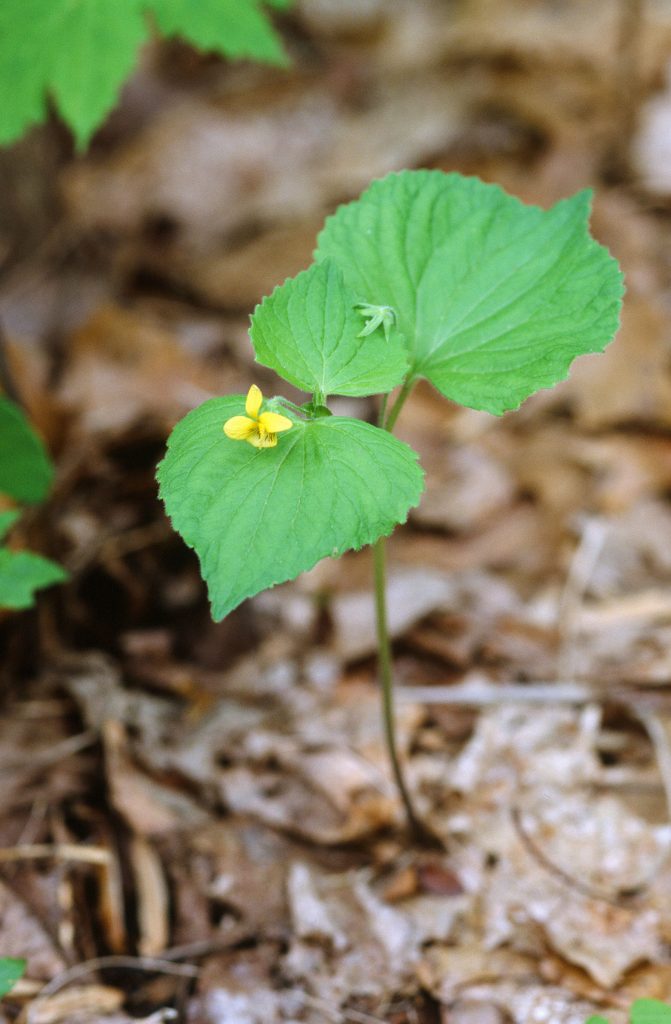


From Reveal, J.L. & J.S. Pringle. 1993. “Taxonomic botany and floristics,” pp. 157-192. In: Flora of North America Editorial Committee (ed.), Flora of North America north of Mexico Vol. 1. Oxford University Press, New York. The text is presented unaltered from http://www.fna.org/Libraries/plib/WWW/Introduction/:
As president of the Royal Society, a position he assumed in 1778 and retained until his death, JosephBanks was able to direct the interests of the society into many corners of the world in search of botanical novelties. The world’s largest collection of plants lay before Solander, and he set to work describing the thousands of new species he was finding. His early death prevented his publishing much, but through the work of his successors as Banksian librarians, Jonas Dryander (1748-1810) and Robert Brown (1773-1858), many of Solander’s names were ultimately published. Unfortunately, the authorship of most of his names for American species must be credited to William Aiton (1731-1793), who, as head gardener for Princess Augusta of Saxe-Gotha at Kew, was the author of the three-volume Hortus Kewensis… (London, 1789), in which most of the names were formally established. Even the efforts of Francis Masson (1741-1805), one of Kew’s foremost collectors, who worked briefly in Canada, were relegated to obscurity in a similar manner.
From Baird, p. 13:
Style heads: V. pubescens and V. eriocarpa have a large oblong to round aperture in front. The hairs of V. pubescens are capillary and are clustered on the sides of the style summit, while in V. eriocarpa they are clavate and form a halo over the head, extending, as it were, from ear to ear (fig. A, 1-2, p. 10).
From: A Guide to The Wildflowers and Ferns of Kentucky by Mary E. Wharton & Roger W. Barbour, the University Press of Kentucky, p. 218:
Lack basal leaves. Pubescent on upper stems and new leaves. Not as common as V. pubescens var. scabriuscula.
V. scabriuscula is more frequent, smooth stems and 1-3 basal leaves, in mesophytic woods, 4-12 inches high.
At Shenk’s Ferry, V. scabriuscula growing on path edges and further into woodlands.
V. pubescens var. scabriuscula on alkaline soils but with more protection, deeper soils and some poplar and maple leaf litter;
2010: In our woods [Radnor, PA], transplanted V. scabriuscula has purple stems, purple basal leaf petioles. V. pubescens are green CHECK.
TM (Thomas Marcussen), 10 July 07:
I have now isolated DNA from all of the samples that I got in the US, and I have obtained test sequences of GPI from several of the Chamaemelanium diploids [2n=12]. I got a full sequence out of V. lobata, which groups closely with V. pubescens and tripartita — probably not a big surprise.
Harvey Ballard says in Violets of Michigan (1994) that hybrids can be found between V. canadensis and V. pubescens where they occur together, but this is probably referring to var. scabriuscula that grows on alkaline as does V. canadensis.
Does V. pubescens always grow on diabase pH neutral? eriocarpa on alkaline. Remember site on Allegheny plateau where V. eriocarpa was in flower, flowers nearly finished, while V. pubescens was just coming up from the ground.
From the Rock Garden Quarterly, Vol. 66, No. 1, Winter 2008, p.11, in an article by Marilyn H.S. Light ‘Along the Lauriault Trail [Quebec]’:
‘Acer pensylvanicum and Trillium erectum grow in soil derived from gneiss, whereas Acer saccharum and Trillium grandiflorum thrive in carbonate-rich soil atop marble. Furthermore, much of the marble is fractured, permitting good drainage and also wicking of moisture from underground reserves during drought.’
On the Bruce Penninsula, Ontario, Canada [alkaline], as along the Lauriault Trail, Viola canadensis and Viola pubescens occur frequently in association with Trillium erectum.
Subtle differences in soil preferences: V. adunca minor on pure limestone; V. canadensis and V. pubescens var. scabriuscula on alkaline soils but with more protection, deeper soils and some poplar and maple leaf litter; V. sororia and V. macloskeyi on limestone substrate with cedar and other conifer needles modifying the soil, also wetter places. There is some overlap, e.g. at Dorion, Cavern Lake where V. macloskeyi and V. adunca minor grow close together but the former in slightly wetter places.
At Walnut Run, on Lancaster/Lebanon border, 3.3m e of 72N on route 322, V. pubescens is found on the north side of the road where the soil is diabase, neutral pH. In the Triassic period the tectonic plates stretched and cracks formed which were filled with sediment from surrounding rock forming areas of sandstone. In this area the molten lava exuded to form diabase in narrow strips, called ‘sills’. Diabase is high in Nickel, Mg and Calcium that makes it different from serpentine which has no Ca. [also different from our circum-neutral soil, which must be lower in all of these three elements.] It is the Mg/Ca balance which is important not whether Mg is high or not!! The diabase produces circumneutral soil [or alkaline, see below] with large boulders (also at the property of Bruce Grimes and Geoffrey Kaiser). Photos of V. pubescens with Anemonella thalictroides (now Thalictrum thalictroides (L.) A.J.Eames & B.Boiv.) on 16 May 1999.
www.enoriver.org/eno/parks/PennysBend/pennysbend.htm The unique plants of Penny’s Bend grow in soils derived from the diabase rock. These soils (Iredell on uplands and Wilkes sandy loam at the base of the slopes) are quite different from typical Piedmont soils. Unlike surrounding acidic or sour soils which have a low pH, Penny’s Bend soils are basic, or sweet, with a high pH. Sweet soil is ideal for certain kinds of plants typically found in other regions of the United States, particularly in the prairies of the Midwest, including Indigo, Lithospermum canescens and Viola pedatifida hybrids. V. pubescens was growing at Penny’s bend in the Wilkes sandy loam, beside the river, where the tree coverage was a little lighter.
I saw plants here with basal leaves, also plants with no pubescence. V. pubescens is defined as having no basal leaves and pubescence on stems and leaves to distinguish it from Viola eriocarpa which is usually found growing on more alkaline soils. The colour of the pods is also very variable, usually green but occasionally dark purple-black (fuscoviolacea). There seems to be good reason to combine these two at least to subspecies relationship and not separate species. At Penny’s Bend Nature Preserve, North Carolina, V. pubescens occasionally has black tomentose pods instead of the usual green form.

At Dunbar Creek, V. eriocarpa is on acid soil (?? changed often from basic to acidic as noted by presence of species typical of each soil pH). Growing together in the Dunbar Valley (4/14/05) were VV. hastata, eriocarpa (basic), rotundifolia, sororia, rostrata (very acid) and blanda (acid). They did not grow where they was Cucullaria (Dutchman’s breeches (alkaline). V. hastata flowers earlier than VV. blanda, rotundifolia, and slightly ahead of V. rostrata, with purple persistent (evergreen) leaves from the previous season, basal leaves, new season shoots of verical stems, also Trillium erectum, Sanguinaria canadensis and Claytonia virginica (Spring Beauty).
At Shures Landing Wildflower Reserve, Susquehanna River, Maryland, USA, April 1990, flower RHS 6A-7A, short sepals, (cf. var. eriocarpa = scabriuscula, which has long sepals?? recheck this), pubescent seed capsules.
Theresa Culley says that Viola pubescens grows under beech-maple forests, but what was underlying rock?). Thomas Marcussen told me that she had done work on V. pubescens comparing it with V. eriocarpa, and found that they were different. Must read her paper.
Niehaus, T.F., Ripper, C.L., & Savage, V., A Field Guide to Southwestern and Texas Wildflowers (Roger Tory Peterson Field Guides), 1984.:
Bright green, heart-shaped leaves on tall, erect stems. Flowers yellow. 10-40 cm high. Rich hardwood forests near streams. NE Texas. March-May flowering.
Atlas of the Flora of the Great Plains: Only occurs on the eastern edge of the Great Plains, with a few counties in the middle in South Dakota, Nebraska, mostly along the Missouri River drainage. [eastern ND, SD, NE, KS, OK, western MN, IA, MO, and a few counties in nw AK]. What limits its range westward? Moisture? Lack of tree coverage? Not cold because it goes north into Canada.
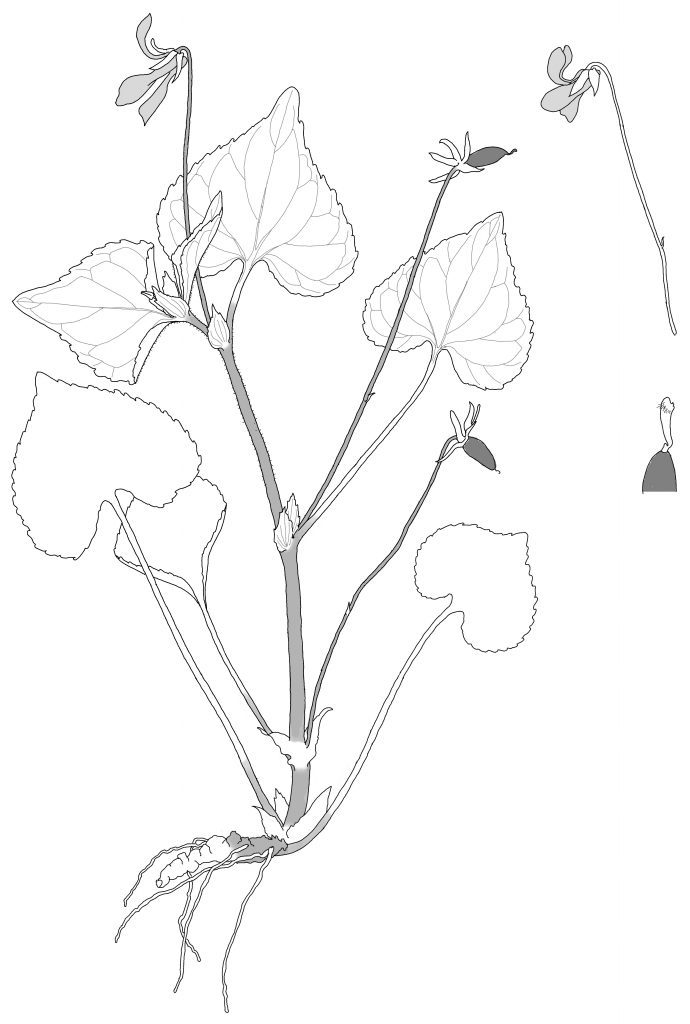
From my article for NARGS bulletin: Viola hastata and Viola pubescens are the two species with yellow flowers produced on stems. Viola pubescens is another taxonomic trap. As the name states, Viola pubescens is pubescent, stem, leaves, petioles, and seed pods. A glabrous form of this species has been called Viola pensylvanica, then Viola eriocarpa, but has now returned to the earliest given name Viola pubescens var. scabriuscula.
To Theresa Culley: Have you ever tested the pH of soil where pubescens and eriocarpa/scabriuscula grow?
Theresa: I have not tested the soil pH where the two varieties of V. pubescens grow. My hunch is that it may not be very different since the two varieties tend to grow intermixed (in my experience). However, Harvey Ballard has told me that he has found separate populations of each, so perhaps soil pH differences might be found in that case..
After trip to Wisconsin: In Amnicon Falls State Park, Douglas County, I saw plants of V. pubescens that had very upright, pubescent stems, with one basal leaf per stem, with either purple or green glabrous pods, different colour pods on different plants. Until I saw the pods, I would have said they were classical pubescens. Purple pods are not pollinated, green ones are??
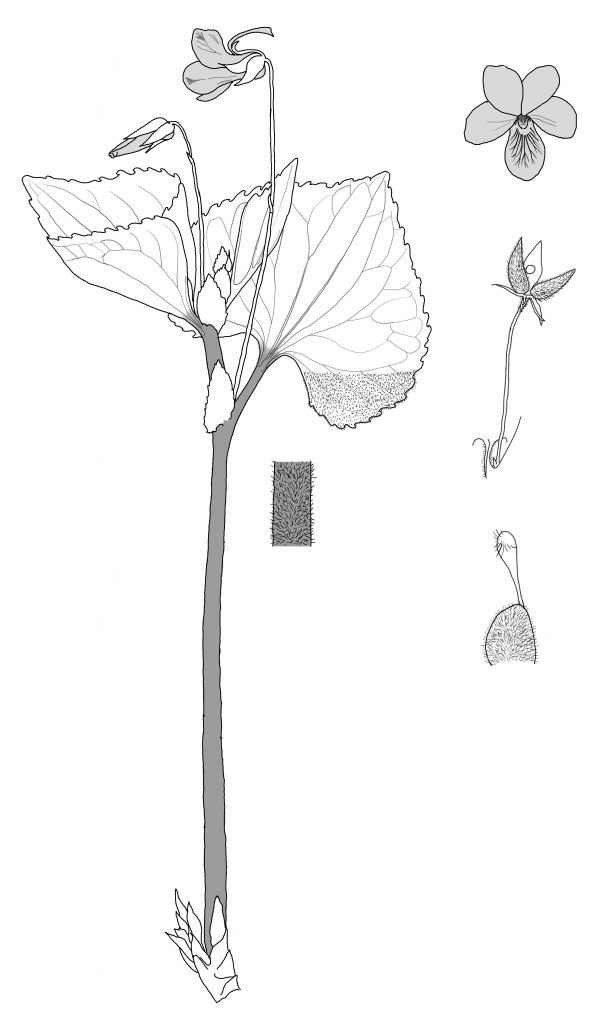
I photographed V. pubescens in my garden in early spring with horizontal early stem growth. Later in the season, late spring to early summer, I photographed the same plant with its pubescent seed capsules and vertical habit. I noted the same thing in western Pennsylvania on Viola scabriuscula in the Dunbar Valley. Maybe this was not scabriuscula. but was glabrous. The plants in my garden are glabrous, multi-stemmed with pubescent capsules. I should check growing habit of V. scabriuscula at Shenk’s Ferry and/or Jenkins Arboretum. [2005, May 17, plants vertical at Shenk’s Ferry]. Must also photograph purple/black pods of plants at Shenks Ferry. [May 17, 2005: Saw purple ovaries on plants but on the same plant developed seeds were green. After long search, did find a few developing seed pods with some purple, but were not uniform dark purple, and took photo. It seemed that the purple ovaries were the flowers that were not fertilized, as none of them was developing. From a description by James C. Parks, Ph.D., Professor of Biology, Millersville University, Millersville, PA, July 1, 1997: Shenk’s ferry is principally a mixed mesophytic forest so the habitat variety is limiting. The site has limestone and mica-schist rock present, contributing to the habitat diversity. The mica-schist is at the end of the long level walk only.
In Somerset county, PA, I saw both V. eriocarpa/pensylvanica/var. scabriuscula and V. pubescens growing within about 10 yards of each other, the former almost finished flowering and the latter just coming up out of the ground. Very confusing.
V. pubescens var. scabriuscula Nutt. ex Torr. & A. Gray (syn. V. p. ssp. eriocarpa) in Anne Rhodes’ The Plants of Pennsylvania, Univ. of PA Press. Also according to Harvey and Theresa Culley.
purple spots on glabrous seed pod, purple appearance, trigonous, large green bracteoles contrasting with purple stem, clavate hollow hairs on back and sides of head of stigma, like a tonsure (V.B-B)
Viola eriocarpa Schwein. (Schweinitz). Am. Jour. Sci. 5:75, 1822. V. pennsylvanica. Incorrect spelling, should be pensylvanica. See comments under V. pubescens suggesting strong evidence for these two being subspecies of V. pubescens. Find and read paper on these two species by Thomas Marcussen’s colleage.
Seeds dark brown, 2.3 x 1.8 mm
Seeds mid-brown.
At Ohiopyle S.P. Viola eriocarpa was growing with Viola rostrata, also Trillium erectum, T. grandiflora, Tulip poplars, therefore pH 7 or more. V. rostrata does not fit in here, it grows on very acid soil, eg. Dunbar Valley floor, but not growing where soil changes to alkaline higher up on the track.
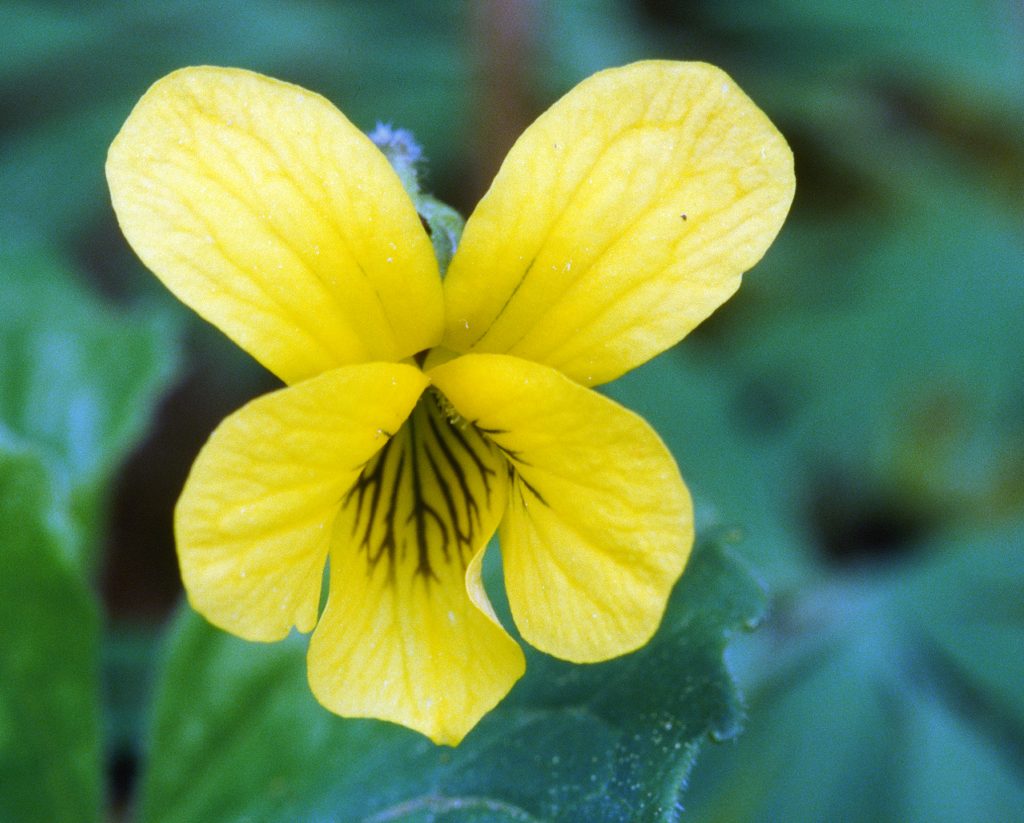
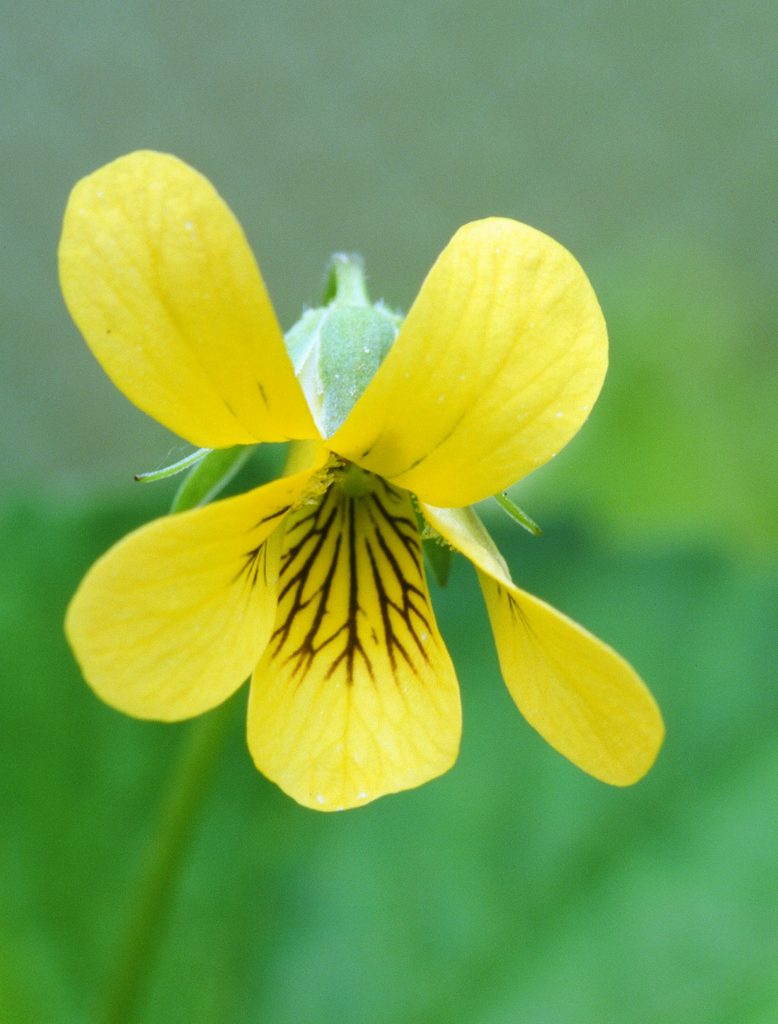

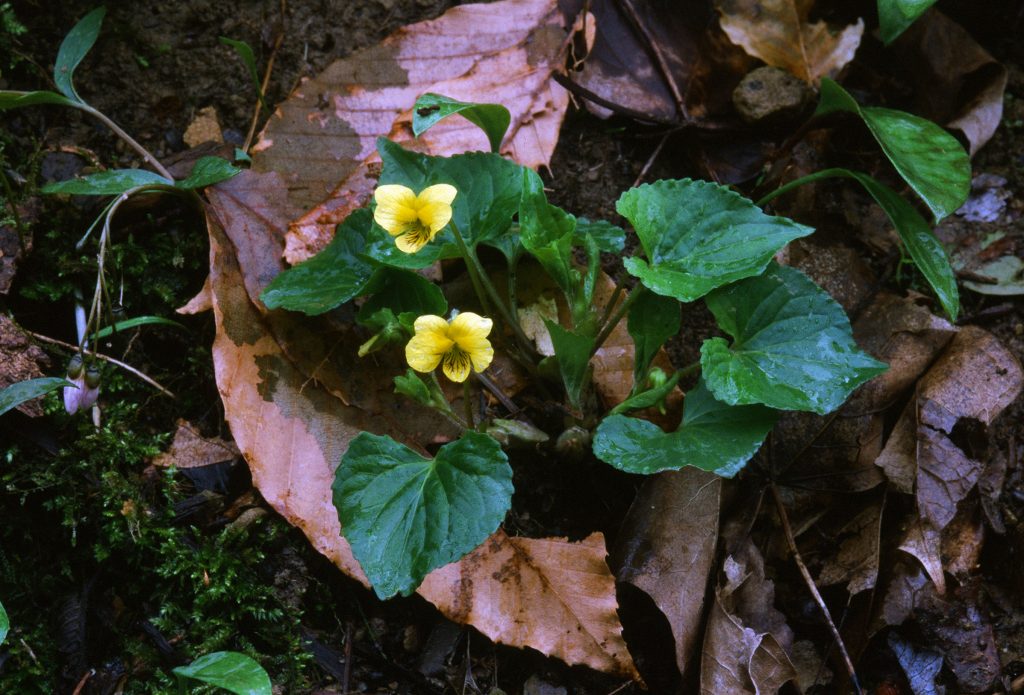
Shenks Ferry Wildflower preserve has limestone and mica-schist rock present, contributing to the habitat diversity. The latter at the far end of the level walk, where the cold air comes out. Here the schist can be seen looking down to the stream from the bridge. Mixed mesophyte forest. [I think the V. eriocarpa is on limestone].
Tim Draude said that he found plants of V. p. var. scabriuscula (which he called V. pensylvanica) with stems growing horizontally, rooting at the nodes so that the whole plant formed a large clump, attractive enough to grow horticulturally. He collected a few of these plants and gave them to Morris West.
Flower RHS 3A, 1.5 cm long x 1.6 cm wide.
Harvey Ballard says that in southwestern Ohio about 90 miles west of where he works/lives (Athens), there is a colony of V. pubescens var. scabriuscula with white flowers.
Hi, Dear,
Well, I’ve got bad news about the albino Viola pubescens var. scabriuscula….It no longer exists! The Shawnee State Park region [Ohio] has been completely refurbished, with new roads leading to new campgrounds, new grooming of the lakeside areas, and new parking lots including gouging out of adjacent slopes. It has taken place within the last year, by the look of it. The changes were so extensive I couldn’t even orient myself based on what it looked like previously. I knew I had managed to find the same place, because I recalled the exact shape of the lake and entrance to it, but everything else was completely different. My grad students and I stopped and explored the whole area, and I was forced to conclude that the slope just above the small gravel parking lot, which is now a much larger 100-car paved lot, is now gone. The slope above for quite a ways up had been scooped out and planted to grass, and that took out the trail where the violets were growing.
This doesn’t mean that the albino might not be lurking elsewhere in the area, but it would have to be found by tedious exploration; no quick stop-in anymore, I’m afraid.
From Harvey re white flowered form of V. pubescens: The Shawnee State Park region [Ohio] has been completely refurbished. I was forced to conclude that the slope just above the small gravel parking lot, which is now a much larger 100-car paved lot, is now gone. The slope above for quite a ways up had been scooped out and planted to grass, and that took out the trail where the violets were growing. This doesn’t mean that the albino might not be lurking elsewhere in the area, but it would have to be found by tedious exploration.
May, 2009: V. pubescens var. pubescens description says one vertical stem and no basal leaves. Pubescent stems. Wider cauline leaves, some reniform, truncate base. Plants from dry upper woodlands. Those I have seen are usually on diabase (dolerite, with fairly high Calcium content). V. pubescens var. scabriuscula description: more than one vertical stem, basal leaves, some hairs but not as pubescent. Cauline leaves narrower, base truncate to tapering into petiole. Plants from lower more moist situations, and from my experience usually on a limestone base.
However, I have seen wide leaves with two stems, wide leaves without much pubescence, and both glabrous and wooly seed pods. And I have seen glabrous or lightly pubescent plants with one vertical stem and narrower leaves with either wooly seed pods or glabrous ones. The boundaries are very blurred. All the defining characteristics can be muddled between two varieties, so what validity do these varieties have.
Plants growing in our garden, upland, dry in summer and not on limestone (pH about 7) have many stems, basal leaves and very pubescent pods.
Should V. pubescens be in the Nudicaules? So what about the multi-stemmed var. scabriuscula??
May 5, 2009: Haycock Mountain, in northern Bucks County, is a ridge of volcanic diabase. Most of the walk will be rocky woods, with plants such as Cimicifuga racemosa, Obolaria virginica, Hepatica, Rubus odoratus, and Cornus alternifolia. In a field of large boulders we will see Adlumia fungosa and Sambucus racemosa … and V. Xpalmata (photographed) and V. pubescens var. scabriuscula (no photos).
TM, June 8, 09: I have difficulties with Viola pubescens. Subspecies pubescens has a vertical stem with no caulescent or basal leaves and should sit with
the Nudicaules in my mind. However var. scabriuscula has both basal and caulescent leaves. They don’t seem to fit together. There are so many intermediate forms also.
Theresa Culley found a quite profound genetic differentiation of the two races, I think in Ohio. Probably there is a suture zone somewhere across the US. But probably this is more complex; maybe some ancestral, more southern meta-populations (e.g. in Pennsylvania) are polymorphic for the “diagnostic” characters? Postglacial migration can generate a lot of confusion.
